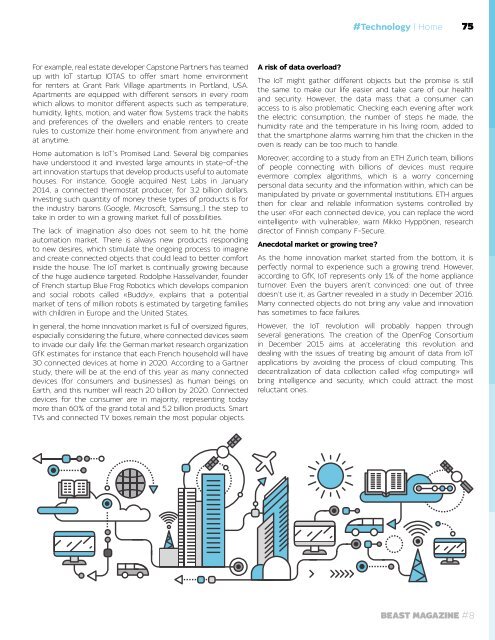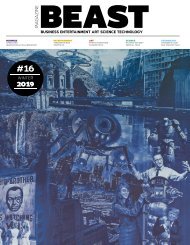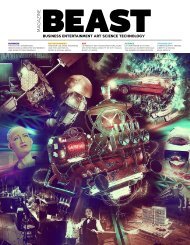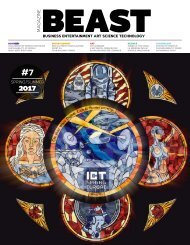Magazine_BEAST_2017_Edition_8_complet
You also want an ePaper? Increase the reach of your titles
YUMPU automatically turns print PDFs into web optimized ePapers that Google loves.
#Technology | Home<br />
75<br />
For example, real estate developer Capstone Partners has teamed<br />
up with IoT startup IOTAS to offer smart home environment<br />
for renters at Grant Park Village apartments in Portland, USA.<br />
Apartments are equipped with different sensors in every room<br />
which allows to monitor different aspects such as temperature,<br />
humidity, lights, motion, and water flow. Systems track the habits<br />
and preferences of the dwellers and enable renters to create<br />
rules to customize their home environment from anywhere and<br />
at anytime.<br />
Home automation is IoT’s Promised Land. Several big companies<br />
have understood it and invested large amounts in state-of-the<br />
art innovation startups that develop products useful to automate<br />
houses. For instance, Google acquired Nest Labs in January<br />
2014, a connected thermostat producer, for 3.2 billion dollars.<br />
Investing such quantity of money these types of products is for<br />
the industry barons (Google, Microsoft, Samsung...) the step to<br />
take in order to win a growing market full of possibilities.<br />
The lack of imagination also does not seem to hit the home<br />
automation market. There is always new products responding<br />
to new desires, which stimulate the ongoing process to imagine<br />
and create connected objects that could lead to better comfort<br />
inside the house. The IoT market is continually growing because<br />
of the huge audience targeted. Rodolphe Hasselvander, founder<br />
of French startup Blue Frog Robotics which develops companion<br />
and social robots called «Buddy», explains that a potential<br />
market of tens of million robots is estimated by targeting families<br />
with children in Europe and the United States.<br />
In general, the home innovation market is full of oversized figures,<br />
especially considering the future, where connected devices seem<br />
to invade our daily life: the German market research organization<br />
GfK estimates for instance that each French household will have<br />
30 connected devices at home in 2020. According to a Gartner<br />
study, there will be at the end of this year as many connected<br />
devices (for consumers and businesses) as human beings on<br />
Earth, and this number will reach 20 billion by 2020. Connected<br />
devices for the consumer are in majority, representing today<br />
more than 60% of the grand total and 5.2 billion products. Smart<br />
TVs and connected TV boxes remain the most popular objects.<br />
A risk of data overload?<br />
The IoT might gather different objects but the promise is still<br />
the same: to make our life easier and take care of our health<br />
and security. However, the data mass that a consumer can<br />
access to is also problematic. Checking each evening after work<br />
the electric consumption, the number of steps he made, the<br />
humidity rate and the temperature in his living room, added to<br />
that the smartphone alarms warning him that the chicken in the<br />
oven is ready can be too much to handle.<br />
Moreover, according to a study from an ETH Zurich team, billions<br />
of people connecting with billions of devices must require<br />
evermore complex algorithms, which is a worry concerning<br />
personal data security and the information within, which can be<br />
manipulated by private or governmental institutions. ETH argues<br />
then for clear and reliable information systems controlled by<br />
the user. «For each connected device, you can replace the word<br />
«intelligent» with vulnerable», warn Mikko Hyppönen, research<br />
director of Finnish company F-Secure.<br />
Anecdotal market or growing tree?<br />
As the home innovation market started from the bottom, it is<br />
perfectly normal to experience such a growing trend. However,<br />
according to GfK, IoT represents only 1% of the home appliance<br />
turnover. Even the buyers aren’t convinced: one out of three<br />
doesn’t use it, as Gartner revealed in a study in December 2016.<br />
Many connected objects do not bring any value and innovation<br />
has sometimes to face failures.<br />
However, the IoT revolution will probably happen through<br />
several generations. The creation of the OpenFog Consortium<br />
in December 2015 aims at accelerating this revolution and<br />
dealing with the issues of treating big amount of data from IoT<br />
applications by avoiding the process of cloud computing. This<br />
decentralization of data collection called «fog computing» will<br />
bring intelligence and security, which could attract the most<br />
reluctant ones.<br />
<strong>BEAST</strong> MAGAZINE #8

















